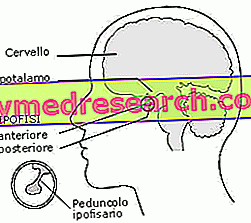In the human race the reproductive function is controlled by nervous and hormonal correlations, that is by the nervous and by the endocrine system, which complement each other.
The central nervous system, sensitive to external and internal (endogenous) stimuli, transmits its messages by processing neurotransmitters.

The hypothalamus belongs to the central nervous system but, from a functional point of view, its neurons are able to receive signals coming both from the upper nervous structures and from the glands of the endocrine system (hypophysis and gonads for example), which are not nerve structures. It is therefore the site where the connections between the central nervous system and the endocrine (hormonal) system occur.
The hormones produced by the hypothalamus are of protein nature (while those produced by the gonads are derivatives of cholesterol, and therefore of lipidic nature) and act on the pituitary gland. It is divided into two portions, one anterior, or adenohypophysis, and one posterior, or neurohypophysis .
The adenohypophysis is connected to the hypothalamus by a system of blood vessels in which the hypothalamic hormones are introduced, thus reaching the pituitary gland. Similarly, again through this system, the hormones produced by the pituitary gland can reach the hypothalamus and influence its function.
Hypothalamic hormones determine, at the level of the adenohypophysis, the synthesis, accumulation, and therefore the introduction into the blood of a series of products that are called tropins because they act on other glands of the endocrine system that are dependent on the pituitary (ovary testicle, thyroid, breast, adrenal cortex, growth function etc ...).
Hypothalamic hormones are referred to as Relasing Hormones (RH), which are substances that stimulate the release and entry of pituitary hormones into the blood.
The RH are:
GnRH or relasing hormone for the two pituitary gonadotropins LH and FSH, acting on ovaries for ovulation induction;
A relasing hormone for pituitary thyrostimoline or TRH agent on the thyroid;
A relasing hormone for the pituitary growth hormone or GHRH ;
A relasing hormone for the tropin that stimulates the adrenal cortical or CRH, in turn causing it to produce the hormone cortisol;
Similarly, there are also hormones that inhibit the secretion of the pituitary gland should this be necessary.
Under the stimulus or inhibition of the hypothalamus, the adenohypophysis produces a series of hormones or tropins of proteinic nature and other substances, such as endorphins, which are also found in the brain and have a chemical structure that resembles that of the opioids.
Pituitary hormones are represented by:
Gonadotropin FSH (follicle stimulating hormone);
Gonadotropin LH (luteinizing hormone);
ICSH (interstitial testicular cell-stimulating hormone) in humans;
Prolactin, important in the preparation of the mammary gland during pregnancy and in its function during lactation. Outside the state of pregnancy, non-physiological prolactin levels can negatively affect fertility mechanisms, and therefore of reproduction;
TSH (thyroid-stimulating tropine);
ACTH (adrenal cortical stimulating tropine);
GH (tropin stimulating body growth);
Furthermore, the pituitary gland produces opioid peptides (endorphins) and factors that affect the liver and pancreas.
Gonadotropins act on the gonads (ovary and testis). The ovary, under the stimulus of gonadotropins, secretes three hormones that derive from cholesterol: estrogens, androgens, progesterone and its derivatives.
In the hypophysis there is also a posterior nerve-shaped lobe, called neurohypophysis, which comes directly from the hypothalamus, this time not through blood but through prolongations of neurons, a series of substances produced by the neurons of the hypothalamus itself. These are then released into the bloodstream and have actions on the whole organism. Among them, the most important are ADH or antidiuretic hormone or vasopressin, responsible for sodium retention, and oxytocin, which stimulates contraction of uterine musculature during childbirth and breast muscle (myoepithelial) cells during breastfeeding to favor the release of milk.



